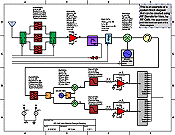Electronics & Technology
- See Full List of AI Topics -
 The distinction between direct conversion, heterodyne,
and superheterodyne receivers represents a significant evolution in radio technology.
Each type of receiver plays a crucial role in the development of modern communications,
and their invention marks important milestones in the history of radio engineering.
To understand these differences, we will explore the invention history, technical
descriptions, and practical implementations of each type, including their inventors,
patents, and notable applications. The distinction between direct conversion, heterodyne,
and superheterodyne receivers represents a significant evolution in radio technology.
Each type of receiver plays a crucial role in the development of modern communications,
and their invention marks important milestones in the history of radio engineering.
To understand these differences, we will explore the invention history, technical
descriptions, and practical implementations of each type, including their inventors,
patents, and notable applications.
A direct conversion receiver (also known as a "zero-IF receiver") represents
the simplest type of radio architecture. It was first conceptualized in the early
20th century as a way to simplify radio designs by eliminating the intermediate
frequency (IF) stage found in more complex receivers. The idea behind a direct conversion
receiver is that the incoming radio frequency (RF) signal is mixed or multiplied
directly with a local oscillator (LO) whose frequency is identical to the RF signal's
carrier frequency. The result is that the signal is directly downconverted to baseband
without passing through an IF stage. The direct conversion concept can be traced
back to Reginald Fessenden in the early 1900s, a key figure in early radio experiments.
Fessenden’s continuous-wave detection scheme laid the groundwork for direct detection
approaches, though the technology for practical use came much later. Fessenden’s
work in amplitude modulation (AM) radio communication formed the foundation for
this type of receiver, although he did not specifically invent the direct conversion
radio as it is known today. Direct conversion receivers gained broader usage in
the latter half of the 20th century with advances in integrated circuit technology
that made them feasible for commercial radios.
The circuit description of a direct conversion receiver involves a local oscillator
set to the frequency of the desired signal, a mixer stage, and low-pass filters
to extract the modulated signal. For example, in the case of an FM radio tuned to
102.5 MHz, the local oscillator would also be set to 102.5 MHz. When the two signals
are mixed, the result is a baseband signal that contains the original modulation
(whether amplitude, frequency, or phase modulation). However, one of the challenges
with direct conversion is DC offset, resulting from LO leakage into the mixer, as
well as image rejection, which is inferior to that of heterodyne systems. The advantages
of direct conversion receivers include simplicity, fewer components, and the ability
to directly demodulate signals without complex intermediate stages. The disadvantages
include susceptibility to DC offsets, LO leakage, and poor image rejection, which
requires additional circuitry for proper signal fidelity. Direct conversion is commonly
used in software-defined radios (SDRs) and other modern communication systems where
simplicity and cost efficiency are paramount.
In contrast, the heterodyne receiver was a major advancement in radio technology,
credited to Canadian engineer Reginald Fessenden and developed further by Russian-American
engineer Alexander Meissner. Heterodyning involves mixing an incoming RF signal
with a signal from a local oscillator to produce an intermediate frequency (IF).
This IF is easier to process and filter compared to the higher-frequency RF signal.
Heterodyne receivers first appeared in the early 20th century, but their complexity
limited their early use. Fessenden is often cited as one of the first to experiment
with heterodyne principles, although the technique was refined by many engineers
over the following years.
The circuit description of a heterodyne receiver begins with an antenna receiving
the RF signal, followed by amplification stages. The RF signal is then mixed with
the local oscillator signal to produce both sum and difference frequencies. The
IF signal (usually the difference between the RF and LO) is selected, filtered,
and amplified for further demodulation. For example, an FM receiver designed to
pick up 102.5 MHz could use a local oscillator set to 113.2 MHz, creating a difference
frequency of 10.7 MHz, which is the standard IF for FM radios. The heterodyne principle
is advantageous because it allows for consistent, selective tuning and amplification
of the IF signal. The advantages of heterodyne receivers include high sensitivity,
selectivity, and improved performance with weak signals. However, the disadvantages
include the complexity of having to design multiple stages, such as local oscillators
and IF amplifiers. Heterodyne receivers were widely used in early broadcast radios,
but their dominance waned with the rise of superheterodyne systems.
The superheterodyne receiver, invented by
Edwin
H. Armstrong in 1918 during World War I, revolutionized radio technology. The
prefix "super" was added to indicate its superior performance over earlier heterodyne
receivers. Armstrong’s invention overcame the shortcomings of direct conversion
and heterodyne designs by introducing multiple stages of frequency conversion, allowing
for even greater selectivity and sensitivity. In the superheterodyne architecture,
the incoming RF signal is first mixed with the local oscillator to produce an intermediate
frequency, similar to the heterodyne receiver. However, unlike the earlier designs,
the superheterodyne system uses a fixed IF, which greatly simplifies filtering and
amplification. Armstrong patented the superheterodyne circuit (US Patent 1,342,885)
in 1920, and it became the dominant radio receiver design for decades, being used
in everything from household radios to military and commercial communication systems.
The circuit description of a superheterodyne receiver involves an antenna receiving
the RF signal, which is amplified and mixed with the LO signal to produce an IF
signal. The IF signal is filtered and amplified through several stages before final
demodulation. For an FM receiver tuned to 102.5 MHz with a standard IF of 10.7 MHz,
the LO would be set to either 113.2 MHz (above the signal) or 91.8 MHz (below the
signal) to achieve the desired difference frequency of 10.7 MHz. Similarly, for
an AM radio tuned to 1200 kHz with a standard IF of 455 kHz, the local oscillator
would be set to either 1655 kHz or 745 kHz to produce the 455 kHz IF signal. The
advantages of the superheterodyne receiver include high selectivity, sensitivity,
and ease of tuning across a wide range of frequencies. The fixed IF allows for the
use of highly selective filters, which are critical for removing unwanted signals.
However, the disadvantages include the potential for image frequency interference,
which requires additional filtering or double conversion stages to mitigate. The
complexity and number of components also increase the cost of production.
The origin of the term "heterodyne" comes from the Greek "heteros" (different)
and "dyne" (power or force), referring to the process of mixing two different frequencies
to produce new ones. The addition of "super" to "superheterodyne" indicates its
superior capabilities in frequency conversion and signal processing compared to
earlier heterodyne designs.
Today, superheterodyne receivers dominate most traditional radio applications,
including AM/FM radios, televisions, and long-range communication systems, where
high performance is critical. Direct conversion receivers have found renewed interest
in modern applications such as software-defined radios (SDRs) and certain digital
communication systems, where simpler architectures and digital processing can compensate
for their inherent weaknesses. Heterodyne receivers, while largely obsolete, laid
the foundation for modern radio frequency technology.
 This content was generated by primarily
with the assistance of ChatGPT (OpenAI), and/or
Gemini (Google), and/or
Arya (GabAI), and/or Grok
(x.AI), and/or DeepSeek artificial intelligence
(AI) engines. Review was performed to help detect and correct any inaccuracies; however,
you are encouraged to verify the information yourself if it will be used for critical
applications. In all cases, multiple solicitations to the AI engine(s) was(were)
used to assimilate final content. Images and external hyperlinks have also been
added occasionally - especially on extensive treatises. Courts have ruled that AI-generated
content is not subject to copyright restrictions, but since I modify them, everything
here is protected by RF Cafe copyright. Many of the images are likewise generated
and modified. Your use of this data implies an agreement to hold totally harmless
Kirt Blattenberger, RF Cafe, and any and all of its assigns. Thank you. Here is
Gab AI in an iFrame. This content was generated by primarily
with the assistance of ChatGPT (OpenAI), and/or
Gemini (Google), and/or
Arya (GabAI), and/or Grok
(x.AI), and/or DeepSeek artificial intelligence
(AI) engines. Review was performed to help detect and correct any inaccuracies; however,
you are encouraged to verify the information yourself if it will be used for critical
applications. In all cases, multiple solicitations to the AI engine(s) was(were)
used to assimilate final content. Images and external hyperlinks have also been
added occasionally - especially on extensive treatises. Courts have ruled that AI-generated
content is not subject to copyright restrictions, but since I modify them, everything
here is protected by RF Cafe copyright. Many of the images are likewise generated
and modified. Your use of this data implies an agreement to hold totally harmless
Kirt Blattenberger, RF Cafe, and any and all of its assigns. Thank you. Here is
Gab AI in an iFrame.
AI Technical Trustability Update
While working on an update to my
RF Cafe Espresso Engineering Workbook project to add a couple calculators about
FM sidebands (available soon). The good news is that AI provided excellent VBA code
to generate a set of Bessel function
plots. The bad news is when I asked for a
table
showing at which modulation indices sidebands 0 (carrier) through 5 vanish,
none of the agents got it right. Some were really bad. The AI agents typically explain
their reason and method correctly, then go on to produces bad results. Even after
pointing out errors, subsequent results are still wrong. I do a lot of AI work
and see this often, even with subscribing to professional versions. I ultimately
generated the table myself. There is going to be a lot of inaccurate information
out there based on unverified AI queries, so beware.
Electronics & High Tech
Companies | Electronics &
Tech Publications | Electronics &
Tech Pioneers | Electronics &
Tech Principles |
Tech Standards Groups &
Industry Associations | Societal
Influences on Technology
|




 The distinction between direct conversion, heterodyne,
and superheterodyne receivers represents a significant evolution in radio technology.
Each type of receiver plays a crucial role in the development of modern communications,
and their invention marks important milestones in the history of radio engineering.
To understand these differences, we will explore the invention history, technical
descriptions, and practical implementations of each type, including their inventors,
patents, and notable applications.
The distinction between direct conversion, heterodyne,
and superheterodyne receivers represents a significant evolution in radio technology.
Each type of receiver plays a crucial role in the development of modern communications,
and their invention marks important milestones in the history of radio engineering.
To understand these differences, we will explore the invention history, technical
descriptions, and practical implementations of each type, including their inventors,
patents, and notable applications. 



